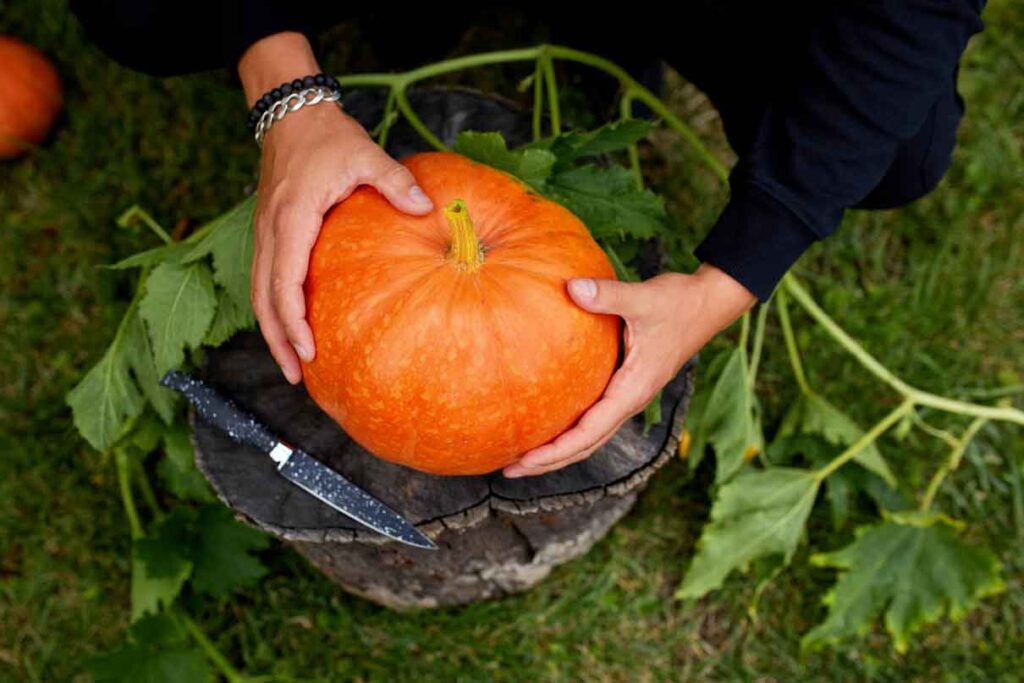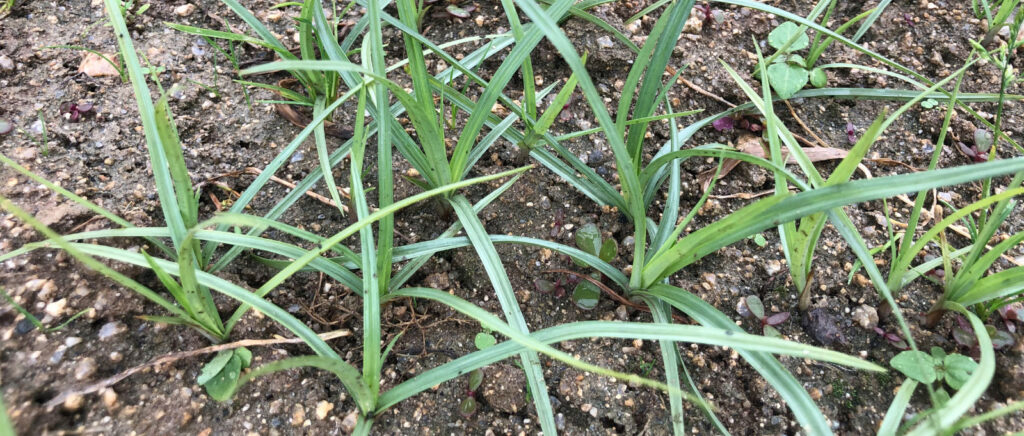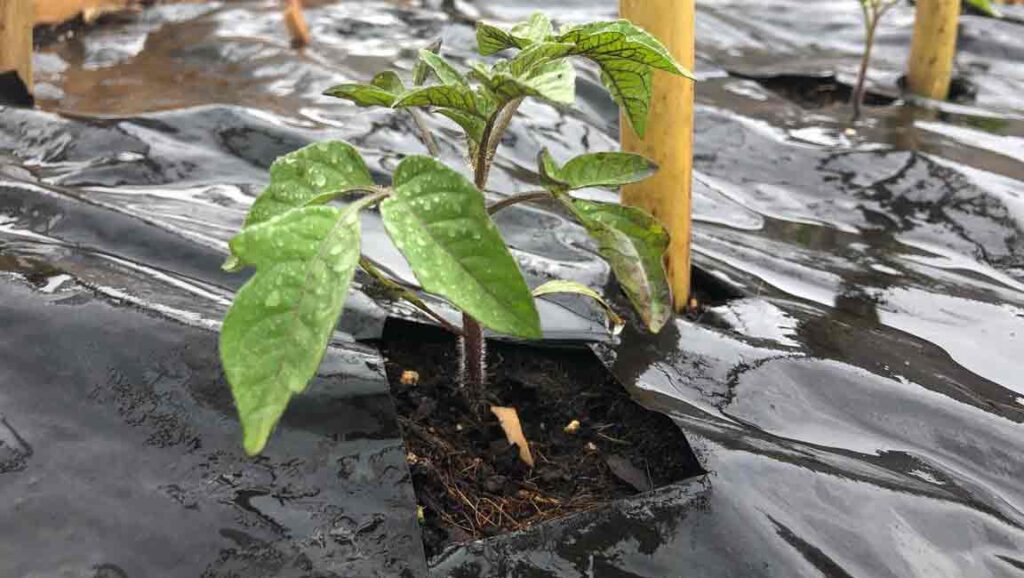Is planting pumpkins a profitable agricultural activity in Europe?
How to plant pumpkins: in recent years pumpkins have become very popular, and are currently highly appreciated globally for their multiple benefits and uses not only in our kitchens, but for their versatility in various fields of industry. This is why planting pumpkins has become a very profitable and successful agricultural activity for many farmers. These highly valued vegetables in the markets provide us with numerous benefits that range from the food industry to cosmetics, pharmaceuticals, the production of animal feed and sustainable industrial applications such as bioplastics, biomaterials and biogas production. Let’s analyze.
Benefits of planting pumpkins as an essential contribution to the industry.
- In the food industry, pumpkins are processed into soups, preserves, purees and ready-to-eat creams, and by dehydrating the pulp and transforming it into a flour rich in fiber and nutrients, it is used to make breads, cookies, pastas and gluten-free products.
- In the snack market it is highly valued for dehydrated products such as pumpkin chips and other varieties, and in some countries such as Spain, citron squash is used in baking to make traditional angel hair.
- In addition, pumpkin is used to produce craft beers, juices and fermented drinks such as kombucha, and pumpkin seed extract is highly valued for its high content of essential fatty acids and antioxidants.
- In the cosmetic industry, pumpkin is used in skin care products such as masks, scrubs and moisturizing creams rich in vitamins A, C and E, and antioxidants that promote cell regeneration and skin elasticity.
- Likewise, the oil obtained from the seeds contains nutritional properties that strengthen the hair’s capillary system, which is why it is used in shampoos, conditioners and balms.
- In the pharmaceutical industry, pumpkin seeds are used in dietary supplements to improve prostate and cardiovascular health and the immune system, due to their high content of antioxidants, zinc and magnesium.
- Pumpkin extract can help control blood pressure and improve cardiovascular health.
- In natural medicine, pumpkin seed oil is widely used to control the appearance and proliferation of intestinal parasites.
- Once we process the pumpkin, we reserve the waste and they are prepared as fodder for livestock, as they contain high water content, fiber and essential properties to improve digestion, which is why it is also added to cookies and treats in the pet food industry.
- In the bioplastics and biomaterials industry, several projects are currently being developed in the field of research to incorporate pumpkin biomass in the production of bioplastics and biodegradable materials, with the purpose of improving environmental sustainability.
- In addition, the fermentation of the pulp and pumpkin residues such as the peel and seeds contain a high level of biodegradable organic matter, as well as carbohydrates, lipids and proteins, which makes it a wonderful source of renewable energy as they generate biogas. Let’s analyze a little about this aspect and see the relationship between this currently so important natural component and how to plant pumpkins.
What is biogas?
- It is a renewable gas that is produced by the decomposition of organic and natural matter, such as agricultural waste, waste from the digestive system of ruminants, in swamps and landfills, and which today represents a key point for the development of renewable energies.
- It is a sustainable energy alternative that contributes to improving the circular economy and climate change.
- On the other hand, when treated and purified, this renewable gas is used to reduce dependence on fossil fuels, reduces pollution and food waste, reduces the emission of greenhouse gases, prevents the accumulation of organic waste, and facilitates access to sustainable energy in agricultural communities.
Let’s review these links to make better use of this information:
https://www.idae.es/tecnologias/energias-renovables/uso-termico/biogas
Biogas from kitchen waste:
How to build a Biodigester:
What is the relationship between biogas and pumpkin?
- Planting pumpkins goes beyond being an agricultural activity.
- As we have already analyzed, this vegetable has a wide spectrum of benefits and uses, and we add one more, and that is that once harvested and processed, we obtain the waste that generates a large amount of biogas, rich in nitrogen, phosphorus and potassium, and which properly processed is an excellent fertilizer for agricultural crops.
Previous recommendations for planting pumpkins successfully.
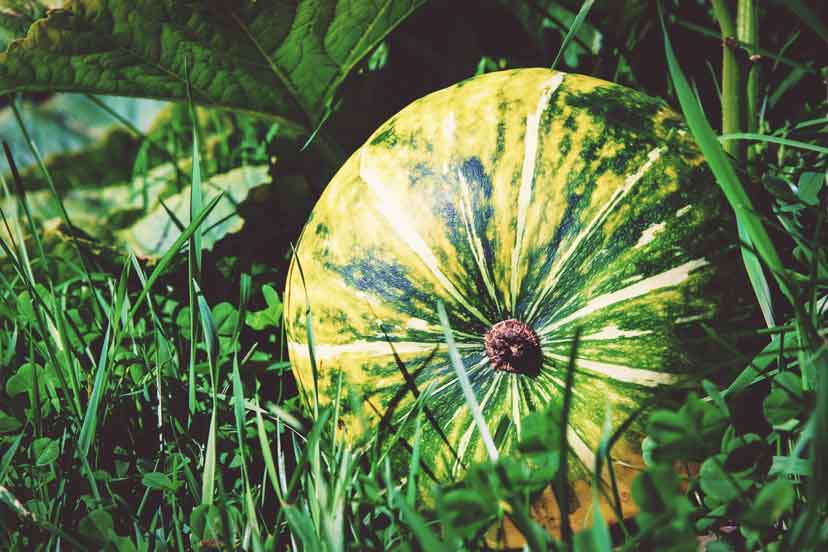
It is important to make a detailed prior plan so that our pumpkin planting project reaches a happy and successful result. For this, let’s gather the essential elements, study the details and “draw our map.”
What type of soil and nutrients do we need to plant pumpkins?
The soil suitable for planting pumpkins must have certain characteristics, since these crops are demanding:
- A sandy loam soil, to provide a perfect balance between good drainage and adequate moisture retention.
- A deep, loose soil, to make the roots expand more easily and be able to absorb the water and nutrients they need. It is important that we remember that compact or easily erodible soils will cause waterlogging problems and consequent root asphyxiation, plus the proliferation of fungal diseases.
- Clay soil is heavy and unfavorable for planting pumpkins, and involves refeeding it with river sand and organic matter to achieve proper aeration.
- A soil with an optimal pH level: between 6.0 and 7.5 will be slightly acidic or neutral, favorable for the absorption of nutrients.
- If it is higher than 7.5, we must compensate by adding organic matter or agricultural sulfur to balance the alkalinity.
- A soil with correct content of organic matter (compost, worm castings, very decomposed and loose manure). We calculate it between 3% and 5%.
- Nitrogen to nourish vegetative growth (first stage of cultivation).
- Phosphorus to strengthen root development and flowering.
- Potassium to feed the development of well-formed, large and resistant fruits.
- Calcium and Magnesium that prevent deformations in the physiology of plants.
- A soil suitable for sowing seeds between 30 and 40 cm deep, free of stones, residual and root elements from previous crops, plastic waste or visible erosions.
Biodegradable paper mulch as a safe method for planting pumpkins.
Mulching is a highly recommended innovative technique because this material helps us reduce costs, protects and maintains the cultivation process impeccable from the beginning to harvest, and due to its biodegradable structure it becomes a fertilizer rich in nutrients for the soil and our plants. next crops and we also contribute to the protection of the planet, since we do not generate plastic waste.
- Furthermore, when we adopt the use of biodegradable paper mulch to plant pumpkins, and as a sustainable and environmentally friendly practice, we manage to maintain the necessary amount of moisture that the soil needs to maintain the balance of our planting, we control the appearance and proliferation of weeds, diseases and pests, we promote the rapid and healthy development of roots, and we achieve an organic and abundant harvest of fresh and healthy fruits.
- Agricultural mulch, especially made with biodegradable materials such as paper, is one of the most effective techniques to conserve nutrients from both the soil and our crop, and due to its composition, it degrades without leaving unnecessary or toxic residues, which is why it is It becomes nutrient fertilizer for the soil, very important for our next crops.
- Benefits: Prevents and reduces erosion, as it protects the surface from the direct and unpredictable impact of excessive rain and wind.
- The biodegradable paper padding allows moisture to be preserved. It reduces water evaporation, and in this way benefits us with responsible and intelligent consumption.
- Due to the effect produced by this innovative and sustainable technique, the soil structure will maintain an adequate temperature necessary for the healthy growth of our plants, and also favors the development of the microbial activity that we need in the substrate. Planting pumpkins implementing the use of biodegradable paper mulch can become a really successful, very profitable and safe activity.
Buy Novamulch biodegradable paper mulch here
-
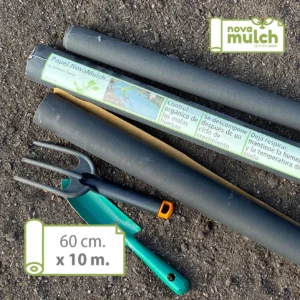 Novamulch paper 60 cm. x 10m.14,85 € IVA incluido
Novamulch paper 60 cm. x 10m.14,85 € IVA incluido -
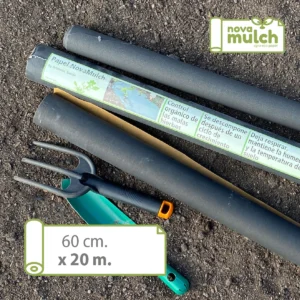 Novamulch paper 60 cm. x 20 m.21,89 € IVA incluido
Novamulch paper 60 cm. x 20 m.21,89 € IVA incluido -
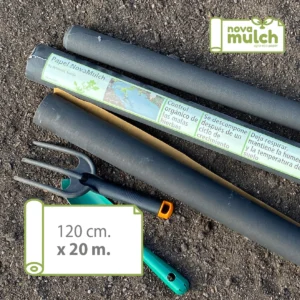 Novamulch paper 120 cm. x 20 m.41,63 € IVA incluido
Novamulch paper 120 cm. x 20 m.41,63 € IVA incluido -
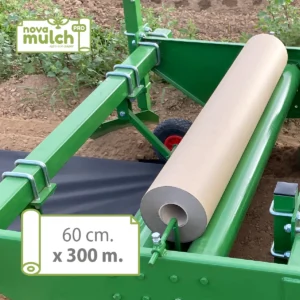 Novamulch Professional Paper 60 cm. x 300 m.47,10 € IVA incluido
Novamulch Professional Paper 60 cm. x 300 m.47,10 € IVA incluido -
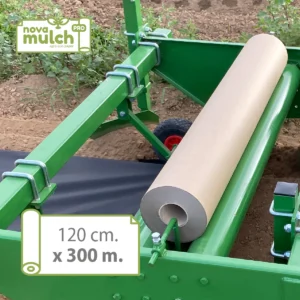 Novamulch Professional Paper 120 cm. x 300 m.94,21 € IVA incluido
Novamulch Professional Paper 120 cm. x 300 m.94,21 € IVA incluido -
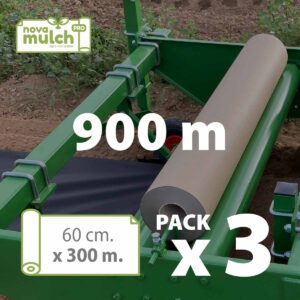 PACK of 3 rolls of Novamulch Professional paper 60 cm. x 300 m. (900 m)141,30 € IVA incluido
PACK of 3 rolls of Novamulch Professional paper 60 cm. x 300 m. (900 m)141,30 € IVA incluido -
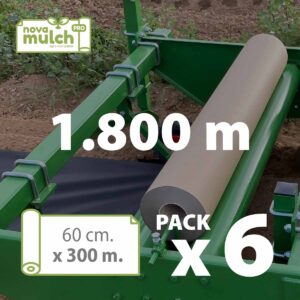 PACK of 6 rolls of Novamulch Professional paper 60 cm. x 300 m. (1.800 m)282,22 € IVA incluido
PACK of 6 rolls of Novamulch Professional paper 60 cm. x 300 m. (1.800 m)282,22 € IVA incluido -
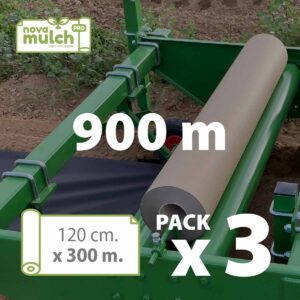 PACK of 3 rolls of Novamulch Professional paper 120 cm. x 300 m. (900 m)282,22 € IVA incluido
PACK of 3 rolls of Novamulch Professional paper 120 cm. x 300 m. (900 m)282,22 € IVA incluido -
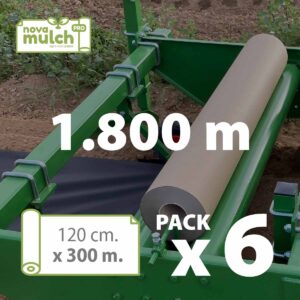 PACK of 6 rolls of Novamulch Professional paper 120 cm. x 300 m. (1.800 m)565,28 € IVA incluido
PACK of 6 rolls of Novamulch Professional paper 120 cm. x 300 m. (1.800 m)565,28 € IVA incluido
Is it necessary to rotate crops?
- This recommendation is essential to improve the pre-existing conditions of any type of soil. In general, rotating and avoiding repeating the planting of the same plant, whatever it may be, allows us to enrich the nutrients and the fertile and productive capacity of the land, and we prevent the development of diseases or infections specific to a species, which generally remain latent waiting for familiar and recurring crops.
- To avoid these inconveniences, after planting pumpkins and in the same portion of soil, we can plant legumes such as beans, peas, lentils, broad beans and clover, as these fix nitrogen through their root system and reduce the need to use fertilizers to compensate or balance the substrate of the new planting.
We continue with a small list of crops in addition to legumes, which we must know to rotate after planting pumpkins:
- Cereals or Grasses such as corn, wheat, barley, oats, sorghum, which require different nutrients, improve the structure of the substrate and will also break the eventual cycle of remaining pests.
- Deep-rooted vegetables such as carrots, beets, radishes, turnips, as their root system will break up the compacted soil and allow new aeration, favoring the absorption of nutrients in the next sowing.
- Solanaceae such as tomato, pepper, eggplant, and potato, which also need different nutrients, help us dissipate and prevent the appearance or prolongation of the “useful” life of specific pests and diseases of our pumpkins, which means that the requirement to use pesticides and fungicides decreases, and thus, planting pumpkins will become a more sustainable, ecological and environmentally friendly activity.
Important note:
At all costs we must avoid the next crop of the same pumpkin family, such as zucchini, cucumber, watermelon, melon, and chayote; They will share the same pests and diseases, and eradicating this problem from our soil will be very complicated afterwards.
Climatic conditions and calendar suitable for planting pumpkins.
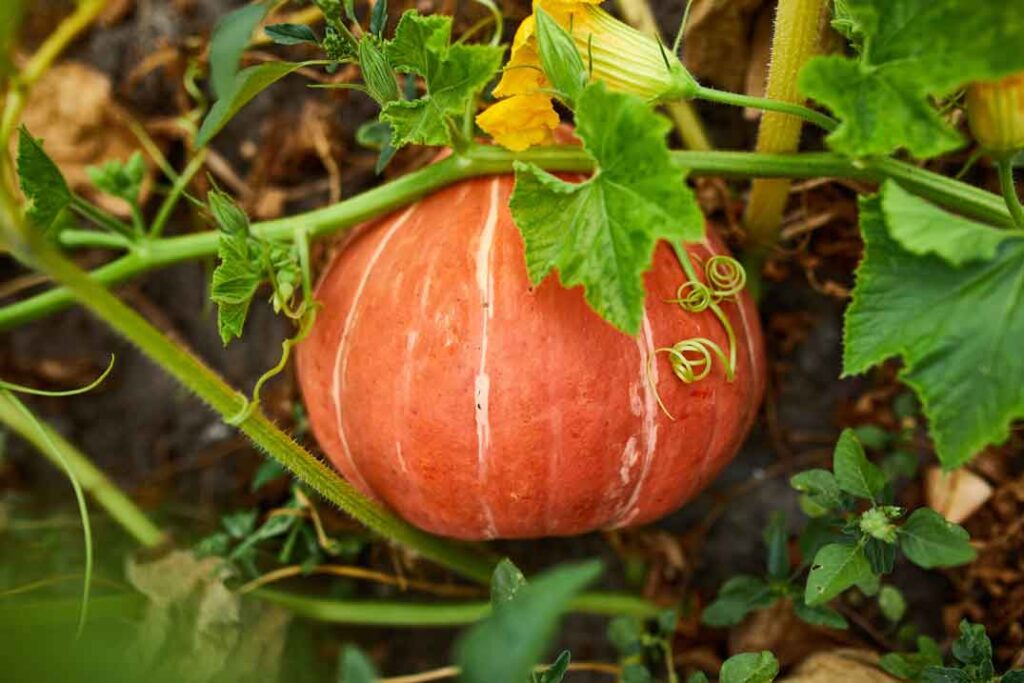
- Warm weather is suitable. The minimum soil temperature required for good germination will be between 15° and 18°C. For optimal growth, the necessary temperature will be between 18° and 30°C. The nighttime minimum should not drop below 10°C, and the tolerable maximum will be up to 35°C.
- If our climate exceeds 35°C, we risk affecting flowering and healthy fruit development, so we must take precautions to control temperature levels and balance adequate exposure to sunlight.
- It is recommended that the appropriate time of direct sun exposure be between 6 and 8 hours, always protected from strong gusts of wind.
- To plant pumpkins we need an area with relative humidity between 50% and 70%, even though these plants adapt to various climates; However, at all times we must have control over water irrigation, and if we use biodegradable paper mulch it will be much easier for us to maintain correct and balanced soil conditions.
- Planting pumpkins is an agricultural activity that, in addition to being very profitable as we already analyzed, adapts to different climates in Europe. Let’s study:
- Temperate regions: it will be in mid-spring and avoiding late frosts.
- Cold regions: we prefer to plant pumpkins in seedbeds, indoors or greenhouses, and it is advisable to do so from February to the beginning of April. In this way we can protect the seedlings from low temperatures and wait for more favorable weather to transplant into the ground.
- In these frost-prone climates, it is advisable to sow these seeds about 2 to 4 weeks after the last frost.
- However, if we choose to plant pumpkins in direct soil, it will be advisable to do so between 2.5 and 4 cm deep, placing 1 or 2 seeds per hole, leaving a space of 1 to 1.2 meters between holes, at a distance of 1.5 to 2.4 meters between the rows, and maintaining a temperature above 15°C.
- For the greenhouse, we will prepare individual pots or special trays to sow the seeds, and the substrate that we are going to use must be loose and rich in organic matter, controlling the temperature that must be maintained between 18° and 22°C until germination begins.
- The correct time to transplant is when we observe that each plant has 3 to 4 true leaves.
- The approximate time from the beginning of planting to harvest ranges between 80 and 120 days, depending on the variety of pumpkins we have chosen.
- We will know when to harvest when the skin hardens and changes color, the stem dries up and when you tap it you will hear a hollow sound.
- The spacing required to plant compact or bush pumpkins is between 80 cm to 1 meter between each plant. Let us remember that they produce long vines and at this distance they will be able to develop more easily.
- Creeping or guiding pumpkins need distances between 1.5 to 2 meters between each one, and in rows with a spacing of 3 meters.
Types and Varieties of pumpkins.
Let’s select the appropriate variety to plant pumpkins: in this space we will review in detail various options that can help us choose the variety that fits our plan.
- If we are going to grow it in large areas, for industrial production, it is advisable to choose varieties with high pulp content.
- If we want to consume our harvest fresh, we can decide on Butternut, Hokkaido and spaghetti squash.
- If we are interested in planting pumpkins for confectionery use, the citron pumpkin (angel hair) is ideal.
- If we are going to take advantage of our harvest for decorative use, planting giant pumpkins (Cucurbita maxima), the so-called Halloween pumpkins, and ornamental varieties, will be the most appropriate.
- Here we show a very valuable and illustrative video:
Particularly in Spain, pumpkin has become an essential ingredient in gastronomy and in our kitchens, especially during the autumn and winter months. Various varieties are frequently grown and consumed in this country, and below we will list the most valued varieties:
Peanut or Butternut Squash (Cucurbita moschata):
- Also known as violin pumpkin, it is characterized by its beige tone, its elongated shape that measures between approximately 20 and 30 cm, its soft and thin skin, its pulp is an intense orange with a dense, creamy texture and sweet flavor, which is why it is very popular and valued as one of the main ingredients in our kitchens, to make pastry recipes, purees, baked in the oven, creams. It is an essential source of vitamins A and C, fiber, potassium and magnesium.
- This variety is native to Central and South America, and that is why it adapts very well to the warm and humid climates typical of these regions.
- As it is a climbing plant, it needs enough space for its growth and prefers well-drained soils rich in organic matter. Planting takes place in spring, and harvesting takes place in autumn, when the skin acquires a uniform beige tone and the pulp reaches its maximum sweetness.
- Let’s analyze these links to better illustrate:
El mercado de la calabaza butternut prevé un notable crecimiento de manera ‘inmediata’
https://es.wikipedia.org/wiki/Cucurbita_moschata
Halloween Pumpkin or Giant Pumpkin (Cucurbita maxima):
- In Spanish towns such as Valtierra and Navarra, international competitions are held that bring together growers from all over the country, and whose protagonist is this variety of pumpkin.
- So far, the second largest in the world established a national record in 2020 with a size of 1,157.5 Kilograms.
- This type of pumpkin is very popular as a decorative element during the traditional Halloween season, in addition to using its pulp in various culinary preparations.
- Planting pumpkins of this type requires certain care, enough available space, having the right nutrients on hand, and following specific growing procedures so that this exceptional size can be achieved, which can exceed 150 kilograms in proper growing conditions. Varieties such as “Big Max” can reach a weight of more than 136 kilograms. To achieve these large sizes and weights we must limit each vine to a single fruit, so that it can be adequately nourished and thus develop to its full potential.
- Its shape is rounded and flattened, its orange skin is hard and slightly rough or striated. Its pulp is yellow or orange in color and has a somewhat bitter flavor, but it is a wonderful ingredient for preparing stews, stews, creams and purees.
- These pumpkins mature approximately 110 or 120 days after the start of planting, and when the foliage of the plant begins to dry, that is when we should harvest.
- Let’s watch this video related to this amazing variety of pumpkins:
Pattypan or Bonetera squash (Cucurbita pepo):
- This variety, also known as Bonetera, Patisson or Peter Pan, reaches a size between 8 and 15 cm in diameter and its shape resembles a flying saucer: with wavy edges and a rounded, flattened shape. Its peel can be white, green or yellow, depending on the specific variety within this family. Its pulp has a firm but soft and fine texture, with few seeds and slightly sweet, reminding us of the flavor of zucchini.
- Very rich in vitamins, iron, magnesium and niacin. It is low in calories: it only provides us with between 20 and 30 calories per cup, very favorable for special low-fat diets.
- As it is a typical plant of warm climates, it requires well-drained substrates, not susceptible to compaction or erosion, and grown in an area with good sun exposure.
- Preferably we should sow it after the last frosts of the spring season, taking care of the flow of temperatures at all times.
- We can consume it before it ripens as well; or stuffed, roasted, sautéed, baked, steamed, grilled, as its mild flavor is ideal, multifaceted, and produces abundant fruits during the season.
- Below is a link of interest to consult:
https://es.wikipedia.org/wiki/Cucurbita_pepo,_C._maxima,_C._moschata,_C._argyrosperma
Hokkaido Pumpkin or Brown Potima (Cucurbita maxima):
- This variety is native to Hokkaido Island (North Sea Circuit), the second largest island north of Japan. It is a winter squash and is also known as “Potimarrón” squash, a term taken from the French: “marrons glacées” (chestnut cream), Potimarrón (Potiron/Pumpkin, Brown/Chestnut), as its flavor reminds us of these fruits.
- This pumpkin is pear or teardrop-shaped, red-orange in color, with a robust rind, its pulp is yellow-orange and with little fiber. It usually reaches a size of 15 cm in diameter and its weight ranges between 1 and 2.5 kilograms. The plant is a climber and spreads, so we must calculate adequate and sufficient space for planting.
- The Hokkaido pumpkin is appreciated as a “gourmet” gastronomic food, for its exquisite flavor and texture. Its bark is edible and high in nutrients.
- It is a source of vitamins A, B, C, D, E, trace elements (phosphorus, potassium, silicon, sodium), unsaturated fatty acids, starch, carotene and natural sugars.
- Its high carotene (pro-vitamin A) content makes it highly valued by the cosmetic industry.
- They require soil very rich in nutrients, organic plant fibers, manure or very dissolved compost material, dry and loose, as they are very devouring plants.
- Here we present a link that can illustrate us in detail:
Citron or Angel Hair Gourd (Cucurbita ficifolia):
- This pumpkin, native to the American continent, is today cultivated and valued worldwide. An indispensable ingredient in baking, pastries and confectionery, citron pumpkin is the author of the sweet known as “angel hair”.
- It is a climbing plant that can reach several meters in length, and produces oblong-shaped fruits with hard, dark green or gray variegated skin with white veins. It adapts easily to temperate and humid climates and is resistant to cold, but not severe frost.
- Its pulp is white and fibrous, with black or brown seeds, rich in fats and proteins, even though its vitamin and mineral content is relatively low. However, traditional Asian medicine implements it to help patients with diabetes, as it has been confirmed that it produces a hypoglycemic effect due to its high levels of D-chiro-inositol.
- Let’s check this link for consultation:
https://es.wikipedia.org/wiki/Cucurbita_ficifolia
Winter Pumpkins and Summer Pumpkins:
In this space we categorize the varieties according to the time of harvest and the characteristics of the fruits according to their texture, flavor, culinary uses and storage.
Summer squashes: They are harvested in the warm months and before reaching full maturity. Its skin is thin and edible, its pulp is tender, with a high water content and its flavor is mild and slightly sweet.
- Index of Summer Pumpkins, which we have already studied in this guide: Zucchini or Zuccini. Yellow Pumpkin or Yellow Squash. Pattypan or Bonetera squash.
- These varieties have a short shelf life due to their high water content, so we must consume them immediately after harvest. They are ideal for salads, stuffed, roasted or sautéed.
Winter pumpkins: we can harvest them when they are fully ripe, at the end of the growth stage. Its skin is thick, robust and inedible. Its pulp is dense and sweet with lower water content than summer squashes.
Index of Winter Squash, which we have also analyzed here: Butternut or Peanut Squash. These varieties have thick skin and we can store them for longer periods of time, always in cool, dry spaces. They are more versatile and ideal for savory and sweet preparations, as well as for roasting, baking, and in puree, soup, and stew recipes.
Links to show us the Acorn or Acorn squash, and for the Spaguetti squash:
Ornamental Pumpkins:
- These varieties that are grown for decorative uses require similar needs to edible pumpkins and special care must be taken to the aesthetics of the fruit.
- To plant pumpkins for ornamental purposes, we need sandy loam soil, with good drainage, rich in organic matter, with a pH between 6.0 and 7.5, in which sun exposure is 6 to 8 hours a day.
- Sowing: we will make holes 3 to 4 cm deep and place 2 or 3 seeds in each one. We will keep a distance of 1.5 to 2 meters between each plant, to allow healthy and proper development. In addition, this way we can observe the entire process of our cultivation more easily.
- Likewise, we are going to avoid planting pumpkins in areas susceptible to gusts of strong winds and frost, which is why the months of April and May are ideal to begin planting in countries like Spain.
- By using biodegradable paper mulch we will optimize the result, the good development of our fruits, as we avoid excessive irrigation (it conserves the necessary humidity for the root system to strengthen and remain healthy, soil compaction and eventual erosion).
- This variety is not edible because the pulp is fibrous and unpleasant to the palate, its taste is bitter and can be toxic to both humans and animals.
- The harvest time in these cases will be between 90 and 120 days, when we observe the hardened skin and dry stems. We recommend storing pumpkins in dry and cool spaces.
- Here we show a link of interest:
https://lacasadelacalabaza.com
Planting pumpkins requires adequate fertilization times.
This step is another key factor for our plan. We must have the necessary nutrients on hand to apply them at the precise times of growth of our pumpkins.
Once the natural characteristics of our soil have been analyzed and before planting pumpkins, we must prepare it completely 2 to 3 weeks in advance by adding compost, worm castings or very well decomposed, dry and loose manure.
- Phosphorus: If the soil does not have the necessary amount of phosphorus, we will add phosphate rock or calcium superphosphate to stimulate root development, and we will repeat the pH measurement to control and level the amounts of nutrients we have up to that moment.
- Nitrogen: 2 to 3 weeks after starting germination or transplanting, and when we have observed the appearance of the first true leaves, we will apply liquid manure or compost tea to encourage foliar development and healthy growth of the structure of our plants.
- We are also going to fertilize before flowering: at the moment in which we observe that the first flower buds begin to appear, we will add fertilizers that will allow us to encourage the proper development of both flowering and fruits.
- We can use wood ash by sprinkling a thin layer around each plant, but not on top of it, and we can also dilute it in water and irrigate towards the roots.
- This nutrient strengthens the plant’s resistance and benefits fruit formation.
- Banana tea or peels: they are rich in potassium and phosphorus. They also enhance flowering and the fruits will be more robust.
- We boil the banana peels in water, let it sit until it reaches a cool to cold temperature, and spray the root zone.
- Mature compost and worm castings: these slow-release nutrients are rich in potassium, phosphorus and organic matter. They are applied around each plant. Let us always remember that these elements must be very decomposed, without solid or fresh particles, which is why we must use them dry and loose, to avoid unwanted contamination.
- Bat or bird guano: rich in phosphorus, potassium and nitrogen. They encourage the development of healthy, good quality flowers, and more numerous, good-sized fruits.
- Here we must soak this material for 24 hours, and then, in the form of tea, we incorporate it into the usual irrigation.
- Seaweed extract: rich in potassium, micronutrients and phytohormones.
Do we need to use phytohormones to plant pumpkins?
Let’s study:
- These are natural organic compounds produced by plants.
- They regulate growth and promote the adaptation capacity and resistance levels of each plant in its development habitat.
- They manage to control each phase of the crop: from germination to fruiting. In addition, they function as defenders against eventual plant stress, as they make them more resistant.
- Implementing them in our agricultural activity allows us to improve and optimize our production and benefit the quality of our fruits, in a sustainable and natural way.
- We can investigate more about phytohormones in the following links:
https://econatur.net/soluciones-cultivo/hormonas-vegetales
- When the pumpkins begin to form, we must fertilize with potassium and calcium to strengthen the structure and development of the fruits: we apply potassium sulfate, wood ash or liquid calcium.
- At the end of cultivation and before harvest time, we can add compost tea or light organic fertilizers. In this last phase we are going to avoid applying nitrogen as it can delay the ripening process of the fruits.
Phases for pruning when growing pumpkins.
Pruning is key in different stages of our pumpkin planting, because by doing it at the correct times we will be able to increase and optimize the quality of the fruits.
- Phase 1: We do the first pruning at the beginning, when the plant manages to develop 4 to 6 true leaves, with the purpose of encouraging the production of secondary branches and the robust growth of each plant.
- This will happen approximately 3 or 4 weeks after germination.
- Procedure: we pinch the main stem just after the 3rd or 4th leaf.
- Phase 2: During the vegetative growth phase; second stage of pruning. When we observe that the plant has developed lateral branches, approximately 6 or 8 weeks after sowing. This will allow our pumpkins to concentrate their growth on the fruits and not on their branches.
- Procedure: For this we are going to eliminate weak or overly long shoots, remove defective or bad leaves and thus improve aeration, and remove branches that are growing without signs of productivity.
- Phase 3: Around 8 or 10 weeks into cultivation, this will be the time when the pumpkins begin to develop their flowers. Likewise here we can promote pollination and ensure that each plant concentrates its energy on productive flowers.
- Procedure: we remove some male flowers and thus avoid wasting nutrients, and if the pumpkins have generated excessive branches, we eliminate those that do not have flowers.
- Phase 4: At the time of fruiting, our pumpkins have probably acquired between 5 and 10 cm in diameter. We will do this pruning so that the main fruits concentrate their energy on optimizing their size and quality.
- Procedure: we leave 3 to 5 pumpkins for each plant and depending on the variety we have chosen. We cut the new shoots and remove the dry or damaged leaves. Always with the same purpose: to allow the concentration of energy to increase our production. Furthermore, by doing this pruning during flowering we will control the entry of sunlight to the entire structure of the plant.
- Phase 5: We are in the time of final pruning; 2 or 3 weeks from harvest. We prune in this phase to accelerate the ripening of the pumpkins and prevent diseases that may occur.
- Procedure: we cut off excessive leaves and any secondary stems that have not produced fruits by this time, as well as eliminating damaged or defective fruits.
- In this final phase we allow the concentration of energy to be complete so that the fruits can finish assimilating the essential nutrients and achieve their correct size and quality.
Female flowers, Male flowers and Pollination in pumpkins.
Here we present several videos that show us quite well:
Pumpkin harvest time.
- Let’s analyze the different methods that are generally used to harvest pumpkins, according to the purpose of production; either in small or home gardens, or in large areas of cultivation. Likewise, we will study what is the right time to harvest our fruits.
- Harvesting Summer Squash: This variety should be harvested 45 to 60 days after planting. At this time they will still be in the process of maturation, still tender and their skin soft. We will do this with the purpose of stimulating continued production.
- Harvesting winter pumpkins: Between 90 and 120 days after planting, we will harvest when our pumpkins are already ripe, with resistant and hardened skin, and having acquired their final shade (orange, dark green, yellow), always depending on the variety we have chosen to plant.
- They will be at their ideal ripening point if the pumpkin is not marked when pressing the skin with our fingernail. Leaves and vines should wither, and stems should dry and harden to signal the appropriate time to harvest. And if we hear a hollow sound when gently tapping the fruit, it will indicate that the pulp is firm.
- These pumpkins can be stored for longer periods of time.
Special considerations:
- If our climate is prone to frost or continuous temperatures below 0, it is advisable to calculate the harvest time so that we can do it before the arrival of the intense cold.
- If we live in humid climates with frequent rains, the use of biodegradable paper mulch is essential to preserve the balance of the soil and plants, and yet we must make the precise calculations to harvest our pumpkins before the frequent water seasons.
- In this case we can locate an area in which the probability of waterlogging is minimal, and plan a comparative analysis of the planting soil so that we can minimize the impact of the rains as much as possible.
- Once our pumpkins have been harvested, we will expose them to direct sun for around 10 to 14 days, so that the skin hardens even more and thus prolongs its conservation.
- We absolutely avoid throwing them on the ground once harvested, as we can cause bumps, wounds or cracks in the skin and impair their useful life by accelerating the decomposition process.
Storage and preservation of the pumpkin harvest.
- We are going to need to be prepared in advance to keep our pumpkins in optimal condition once we have finished harvesting.
- We must organize them in a single layer and at a certain distance from each other, on the same level on very clean wooden racks or shelves, and these surfaces must be dry, warm and ventilated to avoid the accumulation of ethylene, preferably between 20° and 25°C, and for at least 10 to 14 days to allow the fruits to seal any cuts and improve their shelf life.
- With a dry cloth or, if applicable, applying a solution of water and vinegar on a well-wrung cloth, we will eliminate traces of dirt on the skin, thus preventing fungus from developing.
- We must immediately discard pumpkins that show visible cracks, bumps or signs of fungus or rot, as they will contaminate the rest.
- After this time and if we want prolonged conservation, we will place our fruits at a temperature between 10° and 15°C, with a relative humidity of 50% to 70% to maintain control over possible dehydration or excessive humidity.
- In basements without humidity and with relative lighting, or in airy pantries, our pumpkins can be kept well for approximately 6 months.
- If we decide to cut them we have two options: we can wrap them in transparent paper, pack them in airtight containers and place them in refrigerators. This way they can be kept well for up to 1 week.
- If we want to extend their useful life for up to 12 months, we place them in cooking, let them cool, crush and freeze in portions.
- We can also cut them into slices and dry them in a dehydrator or in direct sun, if we are going to use them for soups and stews.
Common pests and diseases in pumpkins.
In this space we recommend reading our guide on “Planting Melons. Complete guide for a successful harvest.”
Plantar Melones. Guía completa para una cosecha exitosa.
There we have analyzed in detail the pests and diseases common to the cucurbitaceae family, such as pumpkins, melons and zucchini. Likewise, we write down the solutions for each of these there, and we recommend taking notes to have them at hand. We hope we can clarify this point that is crucial for our pumpkin planting project.
Final considerations.
- Planting pumpkins is a very profitable and productive agricultural activity in the short term.
- In this guide we have analyzed the entire route through which we are going to travel and enjoy, and
- Ultimately we are going to benefit whether we are farmers of large areas or medium-sized and domestic gardens.
- When we decide to plant pumpkins we assume the commitment of drawing a map, a plan that includes all the essential phases to achieve an optimal result.
- From selecting a suitable soil or one that we can adapt to our requirements, our climate and our purpose, considering the variety of seeds we have available and the sowing calendar by regions and temperatures.
- We also study the benefits and solutions that the strategic use of biodegradable paper mulch brings us, as it serves as a protective support from the beginning of sowing until harvest time, and due to its biodegradable structure, it becomes an excellent nutrient for our next crops.
- We hope that all the points that we have analyzed in this guide fulfill their function as reference and support material for planting pumpkins with excellent results, and are the basis for a profitable, ecological and sustainable business opportunity.
Let’s get to work and many successes!

